
:-)

:-)
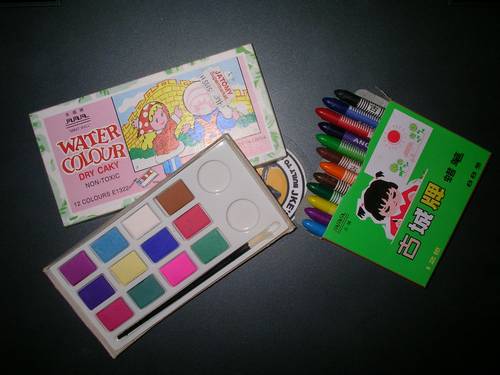
I just couldn’t resist buying these water colours and wax crayons for use in my sketchbooks. 39 and 18 bob for this kitsch trash (Made in China) which fills me with a sense of serendipity.
Seriously, when was the last time you’ve bought wax crayons for yourself?
I’ve been successfully using your GPRS service on my (branded Vodafone!) Nokia 6230i in the past three months, and also took the opportunity to blog about this fine service (here and here) so that other users benefit from this technical progress which really makes a difference for wireless internet access in Kenya.
I am located in a rural area and it just adds lots of convenience to access my emails and surfing the net via my mobile and/or my computer. I wouldn’t want to miss it anymore, and I think wireless telco solutions are the future in Kenya in terms of reliability and accessibility. Thx!
However, there are still some open questions regarding your service which have come in as comments on my blog – and I would like to kindly ask you, or whoever is authorized to give an official statement on GPRS support on Safaricom.
Here are our questions:
Any constructive comments on those questions will be highly appreciated by me and the various readers of this blog. Thx!
@everyone: if you know more or have further questions, pls put them as a comment and I’ll add them to the list…
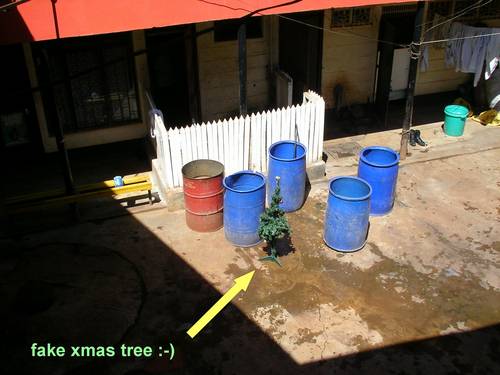
(early morning view from my backyard window)
Seems like the season has officially started in Embu. Now the only thing missing will be “Last Christmas” by Wham!. Hohoho….
Die wahre Kunst, ein Praktikum in Kenia – aufm Land, wo man als Mzungu täglich dumm angequatscht wird und warmes Wasser ein Fremdwort ist – durchzuziehen, liegt darin, sich an verschiedenen Abenden konsequent in eine andere Welt zurückziehen, in der man vor allem den Krach von nebenan aka Nachtclub mit akustischer Dauerpenetration ignoriert, oder zumindest als nicht störendes Hintergrundgeräusch in positive Energie umwandelt.
Gesegnet sind die Abende mit Stromausfällen, an denen ICH hier mal die Mucke bestimmen kann via mein Notebook. Aaaaahhhh.
Seriously, ich würd hier gern mal die ReinigungsCD nebenan in der Bar ausm Player nehmen und bißchen Indy/Emo/Alternative/Punk/Rock einlegen. Oder vielleicht auch Indietronics/Electrotrash, weil das hat ja nen kompatiblen Beat. Dito House.
Gespannt wäre ich dann vor allem auch auf die Reaktion(en) der überwiegend männlichen Barbesucher, die sich an so einem schönen Freitag abend volllaufen lassen und natürlich vorher schon mit billigem Chang’aa (gepantschter Alk aus Eigenproduktion) vorgeglüht haben, um dann später vor den wenigen weiblichen Besucherinnen des Pubs so tun zu können als wenn sie allein vom Bier high geworden sind. Alkohol kostet Geld – und wer hier punkten möchte, bastelt vor allem erstmal an seinem Image.
Gegen frühen Abend werden hier die alten Klassiker aus Zaire/Congo gespielt, die ich selber aufm Notebook habe. Schön. Danach allerdings versucht sich dann ein ungeschickter Flaschenaugust am viel zu aufgedrehten Fernseher, der infolge dessen 2h lang die Besucher mit den sich wiederholenden Tagesnachrichten beschallt. Und irgendwann dann wenn der Fernseher wieder leiser gedreht wurde, versucht sich selbiger ungeschickter Bierflaschenschubser an der Stereoanlage. Die Auswahl der Radiosender erfolgt dann natürlich bei vollkommen aufgedrehter Lautstärke – und das ist für kenianische Verhältnisse auch gar nicht weiter schlimm, denn wer was hat, der zeigt es auch. Außerdem gilt laute Musik als Marketinginstrument: je lauter desto besser.
Nachdem also die Radiomusik irgendwann als zu fad empfunden wurde, und die reichen Kikuyus der Gegend mit ihrem Pickup vorgefahren sind, um in Cowboystiefeln und dem typischen Hut elegant zu trinken, wird die “One Man Guitar” CD eingelegt.
Mit der one man guitar Musik, bei der ein Mann an der Gitarre zu einer sich nach fünf Takten wiederholender Melodie schmutzige Lieder singt (was das ganze ja wieder sympathisch macht, und überhaupt: es is ja zumindest auf Gikuyu), verhält es sich in etwa so wie mit der Akzeptanz von dieser unbeschreiblich grauenhaften “Musik”, die hauptsächlich im Rheinland (ja?) als “Schlagerpop” vermarktet wird. Brauchen wir nicht weiter drüber reden, nich?
Die Musik läuft übrigens den ganzen Tag. Und damit meine ich 24h lang.
Morgens um 7 Uhr werde ich hier täglich durch den Kartoffelaugust geweckt. Im Innenhof – mein Fenster liegt zum Innenhof raus – steht ein Arbeitsknecht ausm Restaurant nebenan und zerdrückt Kartoffeln zu Pommäääs. French Fries. Chips! Täglich. Mehrmals am Tag.
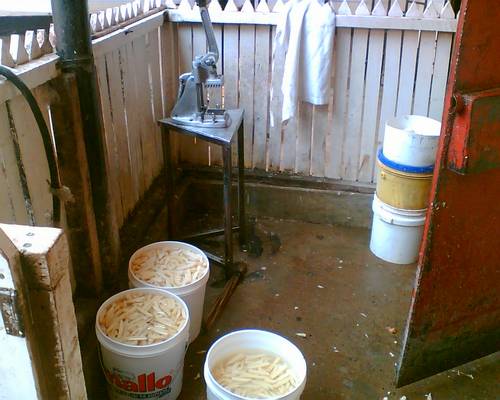
Letztens stehe ich in Nairobi im Nakumatt (Supermarkt) vor der manuellen Pommesmaschine und hab ernsthaft überlegt, ob ich nen neues Arbeitsgerät für meine Nachbarn kaufe. Eines das weniger ausgeleiert ist. WD-40 hilft da leider nicht mehr weiter.
Kaum hat der Kartoffelfachmann seinen Dienst vollbracht, tritt der Schlachter in Aktion, der pünktlich um 8 Uhr morgens die Motorsäge anwirft, um die Kühe fürs Wochenende zu zerteilen. Wochenende bedeutet hier vor allem Abschied vom staple food: unter der Woche gibt es gekochten Mais mit Bohnen in allen Variationen, am Wochenende Fleisch. Gebraten. Gekocht. Gegrillt.
Nachdem die Kuhhälften zerteilt worden sind, kommt die Putzkolonne, die mit Wasser und reichlich Omo den Innehof schrubbt. Der Hof ist nicht wirklich dreckig, aber immerhin zementiert, so daß sich die tägliche Reinigung quasi aufdrängt.
Und jetzt mal zu den Vorteilen. Schließlich habe ich mir hier das alles ausgesucht und bisher noch keine Sekunde lang bereut. Ich mache hier bei der Arbeit genau das was mir am meisten Spaß macht (~ Bastellösungen für technische Probleme finden und mit den Leuten quatschen), ich bin einem super Team das mich vollkommen integriert hat (wer von den Ausländern hat das schon?!) und kann hier jeden Tag Mangos essen. :-)
Nur die Musik nebenan ist echt scheisse.
Home sweet home!
This one goes out to Astrid, Nina and dada Juliane. The July girls. :-)
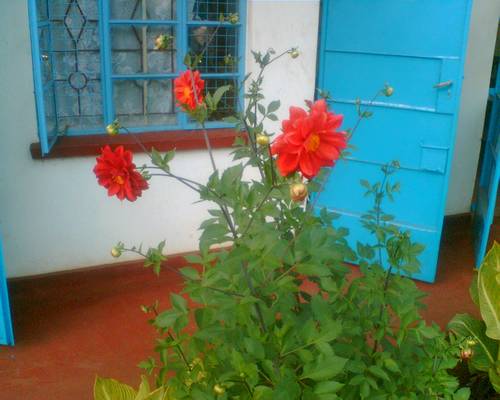

…January,February,March,April,May I’m alive
June,July,August,September,October I’m alive
November,December,yah all through the winter,
I’m alive I’m alive
(“the calendar girl”, The Stars)
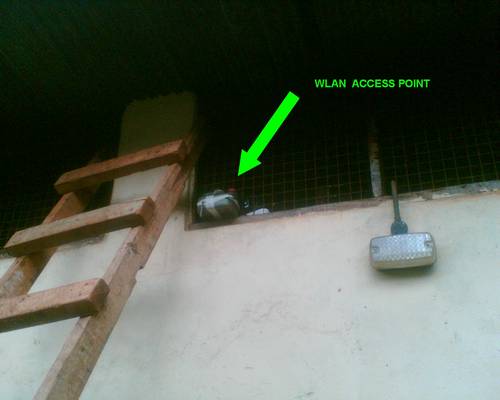
“You can call it: the cheap solution to an expensive problem”, my colleague Zakayo told me. A very cheap solution, yes, indeed.
Some time ago, our offices were provided with some nice HP desktop computers as well as an access point for a wireless local area network (WLAN). Except for the usual problems (e.g. ppl transmitting computer viruses (not virii!) via USB flash sticks), the wireless network had been left switched off as the previous setup could only reach 2 or 3 offices.
To give you an idea of what our compound looks like, pls feel free to check out this panorama view:

(click click => opens in flickr)
The red arrows indicate the number and position of computers, the small green arrow at this former workshop building to the very right is the position of our access point as from today. The access point (AP) used to be in the building to the left – which is why the signals never reached these offices on the other side of the compound.
The access point we are using is a simple D-LINK DWL-2100AP with a small rubber duck antenna that connects via the typical reverse SMA connector. There are in fact external antennas for such accesss points and wireless routers available on the market – even in Nairobi. External antennas come as indoor and outdoor versions. However, these cost between Ksh. 5.000 and 15.000 /= – which of course is a lot money for a simple (repeater) antenna.
I even thought about extending the antenna by using a coaxial cable and the existing antenna or even an additional reverse sma connector (I even thought about building my own antenna using this manual). Yani, the best improvement for any wireless setup (tv, radio, wlan, etc.) is to get a good antenna. Any coaxial cable in between might extenuate the already weak signal, and besides, this is Embu. There’s no 50 Ohm coaxial caboool, neither any reverse sma connector available. And I am just sick of being stopped by unable shopkeppers who don’t even know what they are selling. These gals (!) don’t even have simpoool battely horrdaaass, as mentioned earlier.
I wanted this thing to eventually work. And I didn’t want to spend too much money on this. This is a public service office that survives on donors support, revenue from water permits and salaries through the government @ job groups J & K.
Think of solutions, not problems. (Dan Eldon)
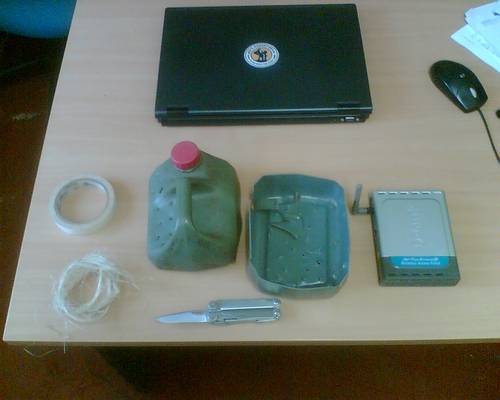
And this is what you’ll need for the outdoor protection of an access point: an old jerrycan rescued from the garbage, some sisal rope, some tape, a sharp knife and, of course, the AP.
I also invested Ksh. 249 /= for a 5m extensiooon cabooool and ….nothing else, actually. These things just do the job.
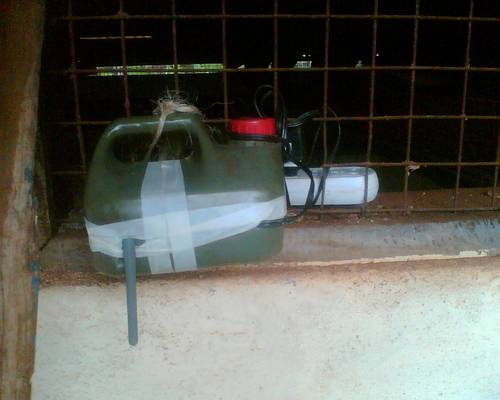
I’ve cut the jerrycan into pieces (just like the salt shaker :-), put the AP inside, connected it to the extended power supply and fixed it to the ventilation windows on this old workshop building (ex provincial water office workshop).
Well, what can I say? It works. It just works. The signal is now strong enough to reach the whole compound, all computers are hooked up, are secured via the typical WLAN security measures and we only spent an additional sum of Ksh. 249 /= which could have been even less by using a simpoool powaaa caboool which sells for Ksh. 45/= /m.
The reason for blogging this is because in the past, I’ve seen a lot of money spent on expensive high-tech whereas simple and cost-effective solutions also do the job. And as long as we’re talking about public funds, the money issue is important, I think.
(funny thing: the wooden ladder as seen in the pictures was made to be heavy so that it doesn’t “walk away” (~ get’s stolen by someone). welcome to the public service! :-)
Aunty Mshairi, the following content is not for your eyes….